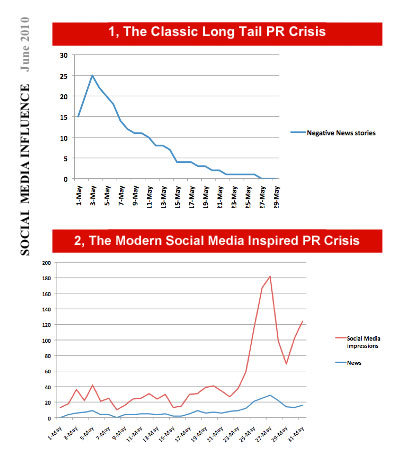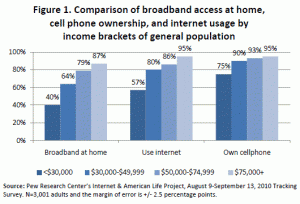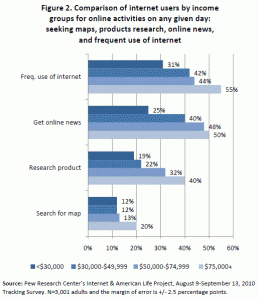An Amazing Social Media Case Study
Here’s an amazing social media case study.
In 2010 Canadian advertising agency john st. took on its toughest challenge yet. Make Chelsea Bedano’s birthday party a success in an already cluttered birthday market. The results were astounding. Funny, no mention of the ROI.
Social Media adds a very long tail to a PR Crisis
Will registering the url, www.BankofAmericasucks.com
help in the event of a PR crisis?
According to Domain Name Wire, Bank of America has been aggressively registering domain names as a pre-emptive move just in case the sensitive, unflattering documents being released by WikiLeaks about a major US Banking institution belong to them.
To make sure the “bad guys” (defined in their world as anyone who would say anything bad about them or their brand) don’t get advantageous URLs, they are grabbing up any URL that could be used against them. Â Like any URL related to Bank of America, management etc with the word “sucks” or “blows” attached.
OK, what is funny about this? Â Well, for one thing, you can’t possibly buy every URL – and even if you could, with URL shorteners, Facebook, Twitter etc, it doesn’t even matter. Â If you “suck” or “blow”, people will know about it and the word will get out.
Out with the old PR Crisis model – In with the New
In the old days, a PR crisis would blow up huge in the beginning when the media got wind of what was going on. Â The PR folks would gather and come up with a strategy, and before you knew it the press had grown tired of your story and had moved on. Â Crisis over. Â Social Media adds a whole new perspective. Â Because Social Media is a long-tail communication tool, it’s harder to predict when the crisis will actually reach media critical mass. Â Often, the press doesn’t even know or care about a problem until it becomes a big deal in social media. Â Once a big deal in social media, the crisis can take on a third life or a 4th or a 5th.
According to an analysis published by Social Media Influence regarding the BP’s social media crisis surrounding the Gulf Coast oil spill,
“A brewing protest movement can come from anywhere. Often it gathers kindred followers online and grows slowly at first. It might attract attention from niche blogs, local news outfits, anybody with some level of influence and following. This added attention is just enough to push the movement into a new more visible light. This initial outside surge of interest is the tipping point, capturing the attention of a whole new group of people, which brings it to the attention now of the mainstream media. After their initial stories, the movement experiences a third life and a fourth. It’s the tail that contains the sting now and it creates a whole new set of headaches for specialists in crisis PR and reputation management.”
“It’s the tail that contains the sting now. Â The half-life of these PR crises extends for weeks, months, even years more and has the capability to reignite yet again.”
The bottom line? Â Clean up your act. Â Be honest and transparent in all of your dealings. Â Follow the golden rule. Â Make a mistake? Â Come clean; really clean, and fast! Â You can no longer sweep stuff under the rug. Â Because social media and web 2.0 will pull the rug right out from under you.
Pew Research: Â Online Brands Should Target Affluent Consumers
According to a recent study by Pew Research Center, the more money a consumer has, the more apt they are to connect and engage online.
Wealthy households have more access to broadband at home and remain connected with  smartphones.
They engage through email (93% use), online news outlets (80%) and also pay bills and donate to charity online.
Higher household income families are also more likely to research health news and information online, look for medical treatments and search for doctors and health care facilities online. They are also more likely to shop online (81% use ecommerce websites), to research products online (88%), make travel plans/reservations (83%), pay bills or use online banks than lower income households.
- 79% of those living in households earning $75,000 or more own desktop computers, compared with 55% of those living in less well-off homes.
- 79% of those living in higher-income households own laptops, compared with 47% of those living in less well-off homes.
- 70% of those living in higher-income households own iPods or other MP3 players, compared with 42% of those living in less well-off homes.
- 54% of those living in higher-income households own game consoles, compared with 41% of those living in less well-off homes.
- 12% of those living in higher-income households own e-book readers such as Kindles, compared with 3% of those living in less well-off homes.
- 9% of those living in higher-income households own tablet computers such as iPads, compared with 3% of those living in less well-off homes.
Examining those living in households with an income of $150,000 or more, there are significant differences with the other income groups. The affluent are significantly more likely to use the internet (30% more) and email (25% more) than the rest of the American population.
Looking more closely at internet users, the affluent are more likely than other internet users to participate in video chat (22% more likely), pay bills online (19%) and get online news (11%).
In fact, technology saturates the lives of affluent Americans. Nearly all (96%) of this affluent demographic use the internet or email. Nine in ten (89%) of the high-income internet users have searched online for maps or directions, 86% have researched a product online, and 82% get a portion of their news online.
How to make “Thank You!”
Feel like “x!@$%# Â You!”
Happy Boxing Day! Â Or should I say, “many happy returns!”
Our family received this advertising mailer (above) from Macy’s on Christmas Eve. Â It was disguised as a “thank you” card with a very special offer inside.
On the front of the card was the Macy’s star. Â Beneath the star was the headline, “two magic words.”
I couldn’t wait to open the card to see what those “two magic words” might be . . .
Much to my surprise, the magic words were “Thank You!” Â And pasted just to the right of those two magic words was a nice 20% off certificate. Â Did you get one too?
Then, as in most Macy’s ads, written in teeny tiny print were the words “exclusions apply , see reverse for details.” Â So I ripped the card out of it’s holder and stared blindly at 13 rows of copy describing in great detail what I couldn’t buy with that nice coupon. Wouldn’t it have been easier to list the one or two items “Storewide” that actually were available to purchase with the coupon?
Hasn’t the social media phenomenon taught marketers to make it easy for consumers, and be transparent? Â Is it just me, or do you just laugh when you are invited to Macy’s latest “Exclusions Apply” sale.
PS. Â The mailer went right into the round file, along with the rest of Macy’s direct mail.
This isn’t the Thank You note that Macy’s sent me
but is my perception of their actual sentiment.
The Social Media (digital) Story of the Nativity
This short video has had almost 7 Million views since it was posted to You Tube on December 13, 2010 by a very talented company in Portugal. Merry Christmas!!
Wishing you a happy holiday season
And a healthy & prosperous new year!
From Klaatu42’s Talking Animals Channel. Someone has much too much time on their hands!!
 I wish I could take credit for today’s blog post, but I’m only regurgitating what David Kirkpatric  (former technology writer for Fortune Magazine and author of The Facebook Effect: The Inside Story of the Company that is Connecting the World) posted today in The Daily Beast. Â
I wish I could take credit for today’s blog post, but I’m only regurgitating what David Kirkpatric  (former technology writer for Fortune Magazine and author of The Facebook Effect: The Inside Story of the Company that is Connecting the World) posted today in The Daily Beast. Â
10 Reasons Mark Zuckerberg
is Time Magazine’s Person of the Year
- Facebook is the fastest growing company in history, surpassing Google as the web’s top destination.
- Facebook was created by Zuckerberg.
- Facebook is transforming lives daily in about 100 languages
- This is a fundamentally new form of communication. In every medium that preceded it, we “sent” a message to another person—telegram, phone call, email, text. But on Facebook you merely do something. The software figures out who sees it. It is the first time real automation has come to mass human communication.
- Zuckerberg, as CEO, has total control over the evolution of Facebook. He controls three of five board seats, and cannot be dislodged or overruled. Facebook really is a reflection of his will and his vision.
- His commitment to the service over his own short-term self-interest was proven in late 2007 when he turned down an offer from Microsoft CEO Steve Ballmer to buy Facebook for $15 billion.
- With a personal net worth of around $10 billion, based on the price of recent sales of Facebook stock in private markets (the company is not yet public), his personal business achievement surpasses anyone his age, ever.
- Facebook has enormous impact in diverse realms—including politics, media, marketing, privacy, our sense of identity, and our definition of friendship.
- Facebook’s impact on the Internet has continued to broaden even outside its own servers. Over 2 million Web sites now use various aspects of Facebook’s software platform, aiming to capture some of the viral communications power that Facebook uniquely makes possible. These platform tools include the “like” button now increasingly ubiquitous across the Web.
- Zuckerberg pushes Facebook to continually change and improve its product, and that has kept it growing and relevant.Â
And I think he’s fun to watch on Television!
And here’s a link to another great post about Mark Zuckerberg and Time Magazine from David Meerman Scott’s blog.
Are you surfing the internet while you watch TV?  If your answer is yes you are not alone. A new study by Forrester shows that US consumers now spend equal time with television and the Internet.
So here’s the big question. Â When people surf the internet and watch TV simultaneously does the content overlap? Â Not really.
According to Forrester’s research the top four online activities have nothing to do with what they are watching on TV.  According to Forrester VP-Research Director, Reineke Reitsma,
“Because consumers are using their PC for activities that require more attention than watching TV – which is mostly a passive activity — it’s questionable how much of the TV content they are even registering. Almost one-third of consumers are playing games on their computers while watching television, and one-quarter are doing schoolwork. Has the TV just become background noise?”

PS. Â I’m writing this blog post while kind of watching ADD & Loving It?! on PBS.
As part of a project dubbed The Social Experiment, more than 600 Shoreline high school students and teachers are giving up texting, Facebook, Twitter and email for a week. You can read all about the experiment in this Seattle Times article.
It’s an interesting experiment, but I think a flawed one. I think the experiment should target controlling the use of social media, not eliminating it.
While students say they are replacing texting, posting and tweeting with doing chores and homework I wonder if that’s really the case? While in high-school I and my friends were skilled at avoiding chores around the house and not doing homework. In fact, we often claimed we couldn’t do our chores because of our study load and vice-versa.
Communication, of which social media is a subset, is vital in society. The fact that we’ve moved from sending smoke signals and carving messages into rocks to the instant dissemination of information doesn’t make the medium wrong, or using it wrong. It just means that, like everything else, we need to be the master of these tools so we run them and they don’t run us. Facebook, Twitter, You Tube, text messaging and email are not going away.
I’ll share those skills with you as soon as I learn to curb my appetite for chocolate.
PS – I wish those students documenting this experiment in video would offer us daily updates. After all, we haven’t sworn off of Social Media.
See what the students think:
And what the teachers think:
Â
PS. These are the same schools that last year created this You Tube video sensation! You gotta like these teachers!!!
 Hey Ya: A music video
I’m playing “blog catch-up.” I started working on a new Friendly Voice website back in July (while on vacation) and have been too busy with client work to tend to my own knitting. A good thing!
A Note Arrives in the Mail!

 Just before Halloween, this note arrived via the US Postal Service (remember them) from my friend and noted art director/illustrator/creative director Rayne Beaudoin.
Just before Halloween, this note arrived via the US Postal Service (remember them) from my friend and noted art director/illustrator/creative director Rayne Beaudoin.
He was letting me know that he had completed work on his book Home Ownership; Welcome to your Delightmare and that it was available for purchase at Amazon.
When I opened the envelope that Rayne had hand addressed, and got my first glimpse at the nice hand written note it contained, all I could do was smile.
After all, I’m a Social Media zealot who counsels clients on engaging internal and external customers through the use of various social media channels day in and day out. Â I live my life online like so many others, inundated with messages from friends, colleagues, advertisers, spammers etc.
Now, this note I got from Rayne will not in and of itself help him at all with search engine optimization. Â But it will engage certain influencers to talk about his book and his novel (retro in 2010) approach to marketing it.
I did something similar when I had decided to sell Bad Animals/Seattle to focus more on creative and less on running a business. Â In 1998 45 rpm records were dead. Â So I sent my voice over demo out to about 300 television stations and networks on vinyl. Â Attached to the 45 rpm demo was stamped postcard offering several options to the recipient.
A) I don’t have a record player, can you please send me a CD?
B) Contact me – we’re looking for a new voice.
C) We’re happy with the voice we have but stay in touch
D) You suck! Â Take me off your mailing list.
Out of the 300 records sent, I received 15 postcards back (one had the “You Suck” box checked) and three contracts; two for domestic TV stations and one with HBO and Cinemax in Asia.
The moral of the story? Â Do something that gets attention. Â Online, offline, wherever. Â Not in-place of your social media efforts, but in addition to them. Â In fact, the dust cover of the 45 I sent out prominently displayed my website address – in rubber stamp.
It was hard and expensive to track clicks back then, but I’m sure the site saw some action.
Who knows, do something out of the ordinary and maybe a blogger will pick up on your novel idea and spread it to the masses.










